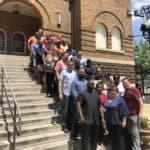Sankofa Reflection 2018: Pastor David Lenz, Hope Church
Long ago I was helped by the book I Know Just How You Feel…Avoiding the Clichés of Grief. The author, Erin Linn, teaches us that we can never fully apprehend the experience of grief someone feels after painful loss. [pullquote style=”left” quote=”dark”]I felt I had come face to face with pure evil. Lord, have mercy…[/pullquote]It is far better to say “I don’t know how you feel” – and humbly to come alongside in love, gentleness, and humility.
This is true as well in race relations. I have known in my head that as a white male I cannot ever say to African American/black friends “I know just how you feel about your experience in American history and contemporary American culture.”

The 2018 Sankofa trip confirmed that truth deeply in my heart.
Confronting the troubled history of race in our nation leads to grief. And lament. And despair. And anger. And bewilderment over how such things could ever come to be. For me, these feelings were greatly intensified because of my African American/black Sankofa colleagues who made themselves deeply vulnerable. They let me and the other white Sankofa participants watch them experience the places where their ancestors were enslaved, stripped of dignity, tortured, lynched, beaten, hosed with water cannons, bombed, and denied basic rights in a variety of unfolding ways.
As we sat in a church basement in Atlanta for our final debriefing meeting, I said that I felt I had come face to face with pure evil. Lord, have mercy. Christ, have mercy. Lord, have mercy upon us.

There were many gripping, sobering experiences, but I will highlight two.
The first was in Montgomery, Alabama, at the Equal Justice Initiative’s newly opened Legacy Museum: From Enslavement to Mass Incarceration (built on a former slave pen, where slaves were imprisoned before being sold at auction). The museum painfully communicates that slavery didn’t really end in 1865; it evolved into new noxious forms such as Jim Crow, lynching, voter suppression, and mass incarceration. I will never forget seeing the wall lined with large glass jars, each holding soil from the place where a lynching took place. Equally impactful, just a few blocks from the Legacy Museum, was the National Memorial for Peace and Justice, another brilliant creation of the Equal Justice Initiative. Over 800 steel monuments are suspended from the ceiling of this outdoor memorial, each recording the names of those lynched in every county in the United States where lynchings took place: over 4,000 from 1877 to 1950. The brilliant design of this memorial expresses the horror of this terror with shocking clarity. [pullquote style=”right” quote=”dark”](Slavery) evolved into new noxious forms such as Jim Crow, lynching, voter suppression, and mass incarceration…[/pullquote]
The second was the visit to the Lorraine Motel in Memphis where the Rev. Dr. Martin Luther King, Jr. was assassinated on April 4, 1968. I could feel the enormity of the loss of Dr. King from the moment I stepped off the bus and took a few short steps to stand beneath the balcony where he perished. Inside the National Civil Rights Museum (that incorporates the Lorraine Motel) I watched portions of the video of Dr. King’s “I Have a Dream Speech.” [pullquote style=”left” quote=”dark”]…deepened fellowship and renewed motivation to follow in the steps of Jesus[/pullquote]Hearing his soaring rhetoric and the magnificent cadence of his voice, in the very place where he died, moved me in the deepest places of my being. I was overwhelmed with emotion – and so grateful that a black member of our Sankofa trip stood with me in the pain and grief of that moment.
I believe the way forward to racial healing and racial justice is through experiences such as this Sankofa trip. What a profound way to face the past so that we can move forward, together. What a blessing to unite Christian leaders, black and white and from every ethnicity, in deepened fellowship and renewed motivation to follow in the steps of Jesus: proclaiming good news to the poor, liberty to the captives and the oppressed, and recovery of sight to the blind (Luke 4:18).
The Sankofa experience generates profound grief. But, as the Apostle Paul reminds us, as followers of Jesus we do not “grieve as others do who have no hope” (1 Thessalonians 4:13). Not minimizing the pain, not ignoring the complexities before us, we nevertheless dare to believe in a better and brighter future. It is our Lord Jesus himself who teaches us that “with God all things are possible” (Matthew 19:26).
 Pastor David Lenz is the Lead Pastor at Hope Church in Richfield
Pastor David Lenz is the Lead Pastor at Hope Church in Richfield


Leave a Reply